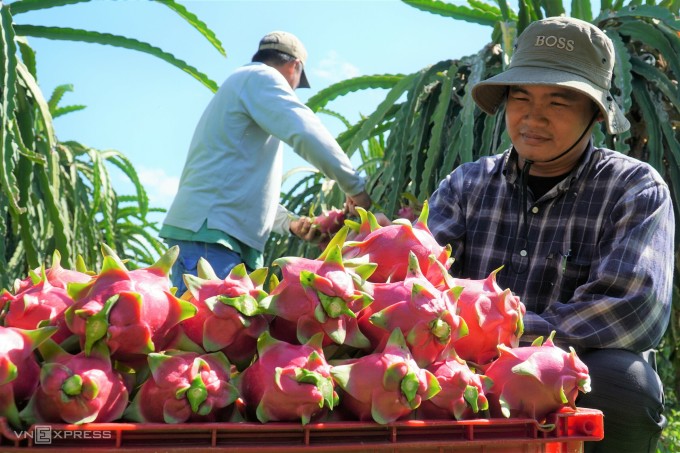Vietnamese dragon fruit faces challenges as exports have decreased for three consecutive years, while Mexico gains market share in the US and Canada, and China and India dominate the supply.
Ms. Hoa, a dragon fruit trader in Binh Thuan , said that since the beginning of the year, the price of this product has increased but she has not been able to export much. "In previous seasons, I sold a few dozen tons a day, but now the output has decreased by half because I can only export grade 1 products," she said.
According to Ms. Hoa, the standards for exporting dragon fruit are becoming more difficult than before, especially for exports to Japan and South Korea, which only reach a few containers per month.
The director of a dragon fruit purchasing company in Binh Thuan also said that his company currently exports a few dozen, sometimes just a few containers of goods per day, while previously the number was hundreds.
Vietnamese dragon fruit is now exported to more than 15 countries and territories. In addition to traditional markets such as China, Thailand, Malaysia, Vietnamese dragon fruit has also penetrated demanding markets such as the US, Japan, Korea, New Zealand, and Australia. Previously, Vietnamese dragon fruit held a monopoly in the international market, accounting for 80-90% of transactions.
However, statistics from the General Department of Customs show that from 2019 to now, Vietnam's dragon fruit export turnover has continuously decreased sharply. In particular, in 2021 and 2022, dragon fruit has fallen out of the top billion-dollar export items of Vietnam. Last year, the export turnover of this item only reached over 632 million USD, down nearly 39% compared to 2021 and down over 49% compared to the peak in 2019.
In the first two months of this year, export activities were more favorable, but statistics from the Import-Export Department - Ministry of Industry and Trade showed that dragon fruit exports reached nearly 106 million USD, down 26.9% over the same period in 2022.

Harvesting dragon fruit at a garden in Binh Thuan. Photo: Viet Quoc
Explaining the sharp decline in export output, business representatives said that there are now many countries participating in dragon fruit production, making the market increasingly competitive.
According to Mr. Nguyen Dinh Tung, General Director of Vina T&T Import-Export Company, China (the main market for Vietnamese dragon fruit) has opened its market, but currently this country is actively cultivating dragon fruit, so import demand is limited compared to previous years.
Specifically, at the end of February, China announced that it had reached an annual output of 1.6 million tons of dragon fruit, 200,000 tons higher than Vietnam, rising to the world's leading position in output. This cultivation productivity nearly meets the country's annual consumption demand of about 2 million tons.
India has also successfully grown this fruit. Recently, the Indian Government decided to build a roadmap to increase cultivation to 50,000 hectares in the next 5 years, from the current 3,000 hectares.
In addition, Mexico has also been able to cultivate dragon fruit, limiting Vietnam's export market share to the US and Canada. Mr. Tung cited that in 2010, Vietnam exported dragon fruit to the US very well. From 2019 to now, when Mexico was able to cultivate this variety, it took over the market share in the US and Canada, making it impossible for Vietnam to export white dragon fruit here (except for a few red-fleshed varieties that the above country has not been able to cultivate).
Businesses also forecast that dragon fruit export output will decrease this year. In the following years, the price of this item will also be difficult to increase if India and China produce large quantities for the market. There is a risk that goods from other countries will be exported back to Vietnam when their prices are cheaper.
Currently, Vietnamese fruits and vegetables are difficult to export to India because of high taxes. However, Vietnam has a trade deficit with India.
In the context of China and India "racing" in dragon fruit output, according to Mr. Dang Phuc Nguyen, General Secretary of the Vietnam Fruit and Vegetable Association (Vinafruit), Vietnamese farmers and businesses need to re-evaluate the market to promote their advantages. In addition to focusing on product quality and design, farmers need to choose the right time for cultivation.
Instead of planting massively as before, it is necessary to increase off-season products, a time when countries like India and China cannot do so. China's long winter makes it difficult to grow dragon fruit. Therefore, Vietnamese farmers should increase dragon fruit planting for harvest at the beginning and end of the year because at this time, products from neighboring countries are very limited and even difficult to produce fruit.
Sharing the same view, Mr. Tung said that Vietnam needs to boost harvesting before or after the other country's products are out of season. To do so, local authorities must inform farmers so that they can prepare and cultivate according to the plan. "We should also promote the cultivation of red-fleshed dragon fruit because this product is difficult to grow in other countries," Mr. Tung said.
In addition, to avoid dependence on markets, according to Mr. Tung, businesses need to focus on deep processing.
Thi Ha
Source link




























![[Photo] National Assembly Chairman Tran Thanh Man visits Vietnamese Heroic Mother Ta Thi Tran](https://vphoto.vietnam.vn/thumb/1200x675/vietnam/resource/IMAGE/2025/7/20/765c0bd057dd44ad83ab89fe0255b783)





































































Comment (0)